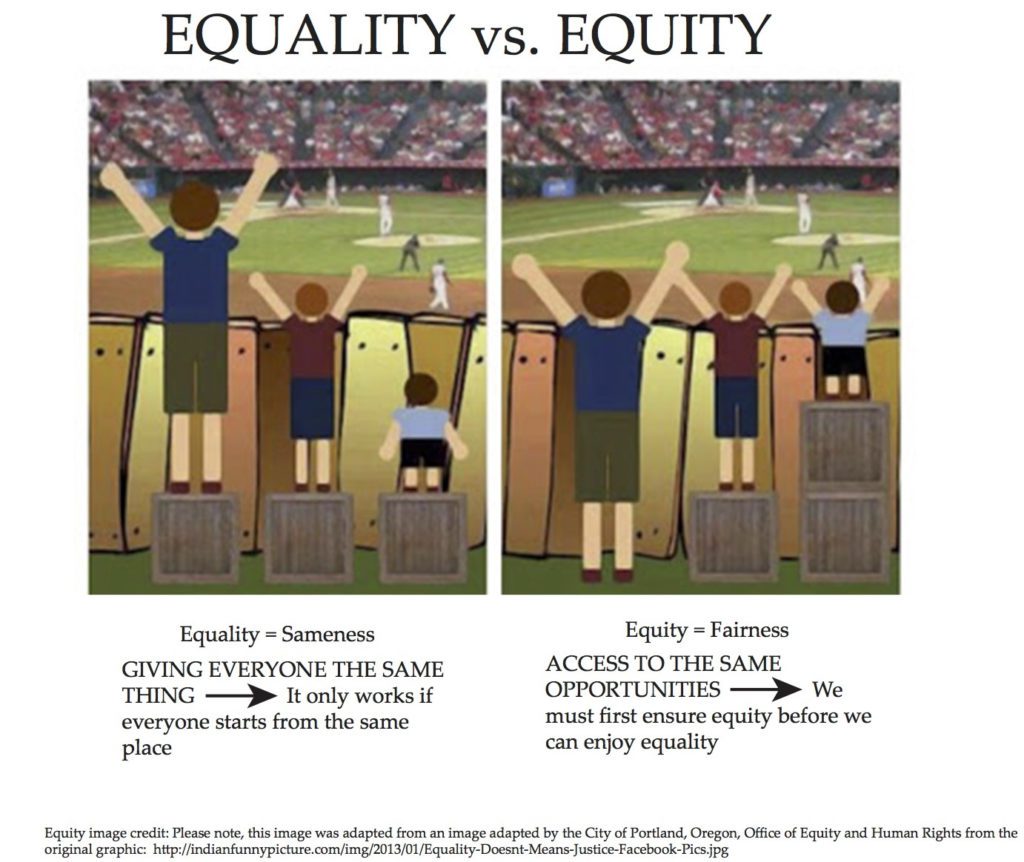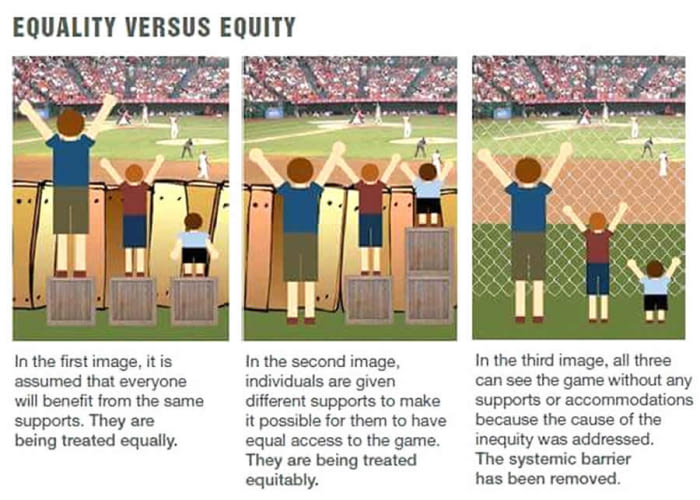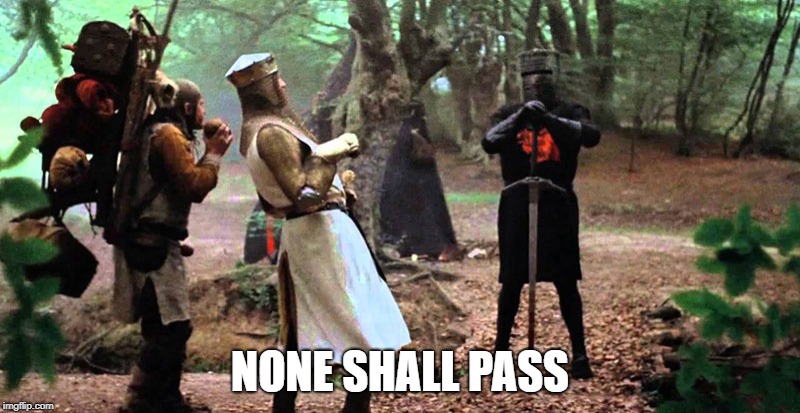The Problem with the Equality vs. Equity Picture
A few years ago, I came across the following image on either FB or Twitter:

Many of you have probably seen this. It has several iterations I’ll discuss later.
Anyway, I would also never have called myself “privileged” or “racist.” No! Never me! I was “tolerant” and “colorblind.” Okay, sure I was homophobic and transphobic (I blame my religious upbringing for that), but I read books…with lots of different types of people and experiences. There was no way I was racist or discriminatory (except for the aforementioned LBGTQA community). I thought “equality” was all we needed.
Fast forward to the beginning of my journey out of the cave. I learned about microaggressions, equity, how colorblindness is polite racism, how we might change individual people but that does little for systems, how we need widespread change, how the Founding Fathers were assholes (I already knew a few had slaves), how most of what I learned in history was a fucking lie told by the conquerors and colonizers, how the classics novels I devoured in high school were tools for spreading those systemic issues, and on and on and on.
Just when I begin to wrap my head around one idea, another pops up or is attached to the original idea. I think I’ve finally hit the roots and can now trace out the branches of all those “–isms.” That brings me back to the picture. Hopefully you’re still reading…
Several years ago, I saw the comparison of equality and equity portrayed in the above picture. It made sense to me. Equity would be giving (I’m using “giving” loosely—not in a patronizing way) each child what they need to see over the fence. Cool. I can do that in my classrooms. No problem.
Then, I realized that also wasn’t enough. We still weren’t doing anything to address the system—we were treating/helping/working with individuals. Don’t get me wrong: it takes individuals working together to change systems, but many of our societal issues are not simply INDIVIDUAL PROBLEMS. So, giving those people boxes to see over the fence doesn’t address there’s a DAMN FENCE IN THE WAY. Then I came across this image:


Now we’re getting somewhere. That wooden fence was removed: the systemic barrier is gone. Once again, I was happy for a little while. But, wait a sec. The wooden fence is gone, yet now there’s a (even taller) chain link fence. Was the barrier really removed or just changed? Those kids (who are all White, I know, but that’s maybe a separate post) can see the game, but they’re still kept out of it. They’re still on the margins—they just have a better view of what they’re missing.
A couple months ago, I started examining this pic again. I found this blog post, which introduces some new pics and solidifies some of what’s been irritating me: http://culturalorganizing.org/the-problem-with-that-equity-vs-equality-graphic/

Here you have general images of people actually tearing down the fence. That allows a view and access to the game. We’re slowly improving this image.

This picture has the same ideas as all the previous ones, but it does use people of color. Still not there, though. I do appreciate how the author of the post also mentions the students are all different heights, so they need boxes (or not) to create equity. "This metaphor is actually a great example of deficit thinking--an ideology that blames victims of oppression for their own situation. As with this image, deficit thinking makes systemic forms of racism and oppression invisible. Other images, like the one of different animals having to climb a tree, or of people picking fruit, suffer the same problem" (Kuttner, 2016). And here's another blog that discusses the problem with the boxes: https://medium.com/@eec/this-equity-picture-is-actually-white-supremacy-at-work-59f4ea700509
Another positive step, but I’m not fully satisfied. Something has continued to nag me the last 3-4 years, but I’ve not been able to articulate it fully. I felt as if I needed to learn more before I opened my mouth. I’m not done learning—not even close—but I’m to a place where I can discuss what continues to haunt me.
Finding these different images helped me nail down what I wanted to say. Although the people are drawn differently, mainly the foreground items don’t differ much. What doesn’t really change from picture to picture? Go ahead and look at them again. I’ll wait….
There are two major pieces that mostly stay the same: the background and the seeming sex of the people. Let’s tackle sex first:
From the back, all but one of the people in the pictures looks like society’s depiction of a male. Yeah, that’s problematic. So, men are the only ones worthy of receiving equity or liberation? Sigh. Those patriarchy roots run deep and true. If you want to know more about the patriarchy, let me recommend a book we’re reading in my Gender and Curriculum class: The Gender Knot by Allan G. Johnson. Yes, it’s a male writing about the patriarchy. Like there haven’t been tons of women writing about it. But, it’s a well written, well thought out book. And, who better to speak to and about the patriarchy to help dismantle it from the inside?
The other element that sees little change is the background. Did you even notice the background? I hadn’t for a while. Each of those pictures features a baseball game. This is what bothers me about this picture—what the baseball game can represent. Let’s deconstruct that a little.
First, what’s America’s favorite pastime? No, not electing complete idiots who know nothing about running a government and then betting on how fast those idiots can bring about an apocalypse. That’s the new favorite pastime. America’s favorite pastime is baseball. Baseball ranks right up there with apple pie, the flag, and Uncle Sam. The pictures could be using baseball to give an American context to the message, or (this is where I lean) it could be a hint of nationalism. That good ol’ American exceptionalism. Systemic discrimination isn’t just an American problem, but, wow, we really do it up right. We’ve had to amend our country’s founding document so many times because this country was founded on racism and sexism. “All men are created equal…” Yeah, that’s males—with penises. Because penises are important. Men who aren’t White? No, they aren’t men. Back then, they even distinguished between acceptable White and those others. When those “other Whites” helped marginalize people, they got accepted into the White boys’ club. This is a good starting place to learn about those “other Whites” becoming accepted: https://www.pitt.edu/~hirtle/uujec/white.html.
Second, the only game depicted is baseball. Why is baseball (as a symbol) the only choice? Wouldn’t true equity or liberation allow for more than one option? Why is baseball the standard all those people are striving for?
Of course, that led me to think of education. As I learn more about colonization; systemic racism, sexism, homophobia, etc.; and systemic oppression, I see increasingly more how much our current education system perpetuates those ideas. Oh sure, there are flames of resistance—mostly begun and tended by marginalized groups—but the system pretty much stays the same. Again, let’s deconstruct this as we figure out why baseball is the only choice offered.
1. This is easy: the majority of teachers are White women. Sorry, but we tend to be foot soldiers for the patriarchy and White supremacy. I’ve said it before, but I’ll repeat myself: White women will throw anyone under the bus if we think we might get the tiniest smidge of power from our overlords.
Plus, we do enjoy a measure of privilege because of skin color, religion, sexuality…whatever status quo boxes you can check. Why upset that and risk losing the privilege and power we’ve managed to beg, borrow, and steal over the centuries? As long as our selfishness supersedes any real fight for equity or liberation, we are just fine teaching kids baseball is the only true American sport, and everyone should try to be baseball players. If you’d only try harder, pull yourself up by your bootstraps, you could totally walk onto that field. Wall around the field, you say? Pshaw! There’s no wall—you just don’t have enough grit or a growth mindset. Look at that field: there are a few from your group out there. Those people…yeah, those people tried hard. It’s an individual problem, not a systemic one.
Ahh, White women, the damage we do as citizens and teachers just to please those White dudes. We have got to stop cheering them on and supporting their shitty decisions just to save our own tenuous positions.
2. I’ve quoted this so much, but thank you, William Pinar, for this question: “What knowledge is of most worth?” I also want to add my own questions, “Who is choosing the curriculum? Who is setting the standards? Why are those the standards? Who makes the decisions that all kids need to excel in these specific areasto be labeled ‘successful?’”
White people make most of our curriculum choices. White people wrote most of our tests. White people make up most of those education “experts” and edu-stars. White people also make up most of the curriculum and testing companies. Most of our standards were written by…come on, folks, you know the answer: White people. And, as stated before, most of our teachers and administrators are (say it together): White people.
Let’s extend this idea…
Soooo, if White people are in power and controlling most of American education, for whom do you think all this stuff is being done? I’m guessing their White kids. How else does systemic oppression and discrimination get perpetuated and learned? Someone has to teach it. Sure the parents are doing a good job, but tough work like maintaining your hierarchical status requires real (White) experts.
Of course we’re going to set standards White children can achieve. That’s going to be our bar and everyone much reach it to graduate, go to college, and even hope of being competitive in the job market.
That means we push things like Standard English (SE or SAE), a term used in Oklahoma’s ELA standards and Common Core (used in the intro and throughout the standards). We push formulaic writing. We push the literary Canon. We worship standardized testing, even though studies have shown those tests are discriminatory and really only tell us a student’s socio-economic status, which is also related to racism. We push Advanced Placement classes (mostly for White kids because College Board’s “rigorous” standards are aimed toward those status quo demographics, but thank god for those few model minorities to help College Board look like they don’t discriminate). We push four years of English, three of social studies (mostly White history), three of math (but let’s push as many kids as we can toward those higher maths, whether they need it or not), three of science, and a handful of electives (also decided on by those mostly White people in charge of curriculum decisions).
Why does every kid have to fit this prescribed mold? Why does every kid need to reach these standards?
I’m trying to figure out how to tap into my wide range of students and their wide range of talents and voices, but also make sure they can play “baseball,” since it’s the only approved “sport” for American students. I’m scrambling trying to fight the system but not put more hurdles in my students’ paths. Those not status quo have to learn to code switch to even hope to survive, much less thrive, in this status quo world.
And, goddamnit, that pisses me off.
Many of my current students are already working on being bilingual, but now they also have to learn SE so people have one less thing to hold against them. Why do they need to learn to make me and other Whites (and other status quo groups) more comfortable? Why must they all attain the same fucking thing?
Why does my student who spits incredible rap lyrics and has an unerring sense of rhyme and rhythm need to learn all the shitty comma rules? Hell, White people don’t even know or use commas correctly, but I’m supposed to suppress him, mold him, force him through a White crucible, and turn him into something that maybe (MAYBE) society won’t chew up because he doesn’t match the status quo.
Why does my student who sits every day and writes about his anger issues and his life (without much punctuation or care for spelling) need to learn the 5-fucking-paragraph essay? Why do I need to squash his outlet and tell him that’s “not proper English”? Why can’t he go to college and be successful in that higher echelon of academia?
White educators, it’s past time for us to open up the playing field and open ourselves up to other possibilities. So what if a kid never learns the Pythagorean theorem? Can that child still find success elsewhere? Big deal if a kid doesn’t read and worship the literary Canon. Does that kid read and enjoy and learn from other books. The amount of dust on a piece of literature does not measure its literary value. Rather, that literary value and all our other “values” are social constructs designed to perpetuate and uphold the status quo. Period.
Next time you are called on to make choices for your students, don’t just throw them a box or change the fence and think you’ve done enough. Nope, it’s past time to tear down those fences and let ALL our students find their own games. It’s time to stop relegating certain student groups to the benches or, even worse, behind the fence. Every single student can become successful if we change the “rules” of what qualifies as success.
There is no “lowering of standards” or (gasp) “dumbing down” of curriculum. Rather, White teachers need to stop being gatekeepers or bouncers and only allowing the status quo or the “model minority” onto the field. Just as children are individuals, so, too, should be their paths.
Maybe if White teachers would stop feeding the discriminatory systems, we might be surprised how quickly those “achievement gaps” close and how we “magically” solve so many of society’s ills.

It’s past time for White educators to stop acting like the Black Knight. It’s time we burn the bar and teach each student how to find success in whatever area they want. It’s time we stop churning out only baseball players, benchwarmers, spectators, those desperately trying to scalp a ticket just to get inside, and those who remain behind the fence. It’s time to open up the field to more than the White possibility.
Until then, I guess I’m going to continue to teach all my students how to “batter up” and play this shitty systemic game because they all deserve a chance at that American Dream—even if those odds were deliberately built against most of them.